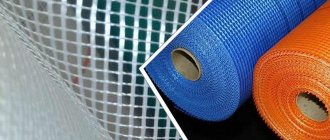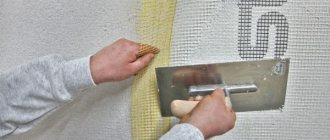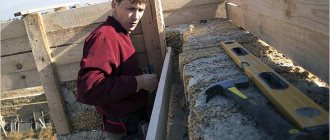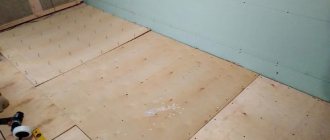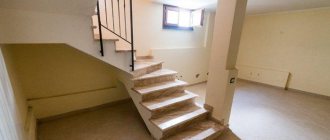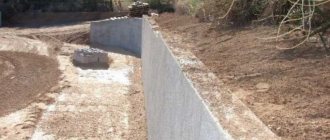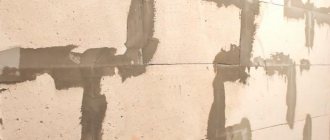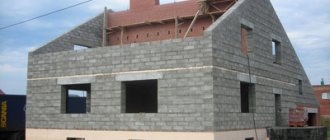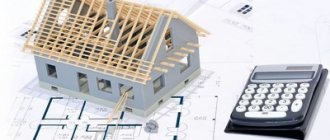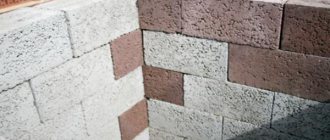In order for the house to be quiet, the decision about soundproofing is made at the design stage of a new house.
This is especially important if it is located close to busy highways or other noisy areas.
A special case of construction is houses made of foam blocks, which take care of most of the noise and sound protection. If this is not enough, when it is necessary to create an atmosphere of complete silence in the rooms, additional noise insulation of the foam block is installed during the finishing work.
Often, for this purpose, traditional thermal insulation materials are installed, which also have additional noise protection. It is important not to completely close the walls, giving them the opportunity to “breathe”.
Cork
An environmentally friendly wood material made from oak bark and having a porous structure.
All cells are filled with inert gas. It has positive qualities in sound and heat insulation when used in residential premises. Not used outside. Materials made from technical cork provide excellent sound insulation. It can be divided into three application groups:
- Agglomerate panels are made from crushed cork oak bark, followed by steam treatment and then pressed. Since the bark contains the adhesive substance suberin, unnatural additives are not required. Two types of panels are made: white - from bark taken from tree branches, and black - from stem bark.
- Natural cork - used for decorating rooms. The panels are additionally coated with wax, after which they will not be able to absorb moisture and odors.
- Cork granules are used for insulation of frame buildings.
Article on the topic: Effective materials and methods of soundproofing a ventilation duct
Technical cork is produced in three forms: sheet, rolled, and in the form of mats.
Roll insulation is most often used as a backing for wallpaper. It comes with or without antibacterial and fireproof impregnation. It is produced in lengths of 10 m and widths from 30 cm to 100 cm. Special glue is used to secure it to the surface of the walls.
Cork in the form of mats and sheets is used to insulate floors, walls and ceilings indoors. Also well suited for sound insulation on the inside of a roof, the covering of which is made of metal tiles or corrugated sheets.
Advantages of cork:
- low thermal conductivity - 0.042 W/m K,
- is resistant to deformation;
- good sound insulation properties - reduces noise by 17 dB;
- excellent antistatic properties;
- environmentally friendly;
- durable;
- natural material.
Working with cork does not require additional physical effort, as it is easily cut to size and convenient to install.
Cost of work
In order to determine the cost of installing a sound protection system, first determine the volume and cost of the necessary building materials.
Calculation of the amount of building materials for sound and noise protection of walls made of foam blocks:
Wall dimensions: H height = 2.75 m, L length = 5.00 m, then S area = 13.75 m2.
To ensure sound and noise protection for walls made of foam blocks, installation of plasterboard, special material for sound protection, as well as plastering of the wall surface will be required. In total, the average cost of work in the Russian Federation will be 700-1000 rubles per m2 .
Acoustic comfort in rooms
To isolate a room from external sounds, materials with the following properties are used:
- soundproofing. Sound waves are reflected;
- sound absorption. The energy of sound waves is converted into other types of energy;
- vibration absorption. Reducing the level of vibrations that spread from external sources through the internal rigid structures of the building.
Requirements for the quality of sound insulation depend on the purpose of the room. Thus, the premises of a recording studio will require maximum protection from extraneous sounds or vibrations. Good sound insulation should be in bedrooms and rest rooms. In trading floors and warehouses, the requirements for sound insulation are not strict. In some cases, on the contrary, it is installed indoors so that noise from it does not penetrate into neighboring rooms.
For good sound insulation when performing interior decoration, wall partitions, ceilings and floors are arranged as a multi-layer structure. One of the layers is soundproofing material. Mineral wool is often used as it. For most rooms, this material is used as noise protection and as insulation.
Materials for work
In most cases, for external noise protection, complex materials are used that can also protect the house from heat loss and moisture penetration, which are covered on top with protective finishing boards or decorative plaster.
The most popular and affordable materials used for sound protection are:
- Classic basalt mineral wool with sound-reducing and heat-protective effects. The most accessible and inexpensive material can completely make the house quiet. There is only one drawback - the high width of the protective layer.
- Materials obtained as a result of eucalyptus, bamboo or coconut processing. In many respects, functionality and durability, they are practically no worse than mineral wool, but at the same time they are environmentally friendly.
- Cork mats are currently considered the best internal sound insulator, due to the fact that it effectively blocks sound even with a relatively small layer thickness. It is used as an interior finishing material for individual artwork. There is only one drawback - the high cost of both material and finishing work.
Cork covering
Improved sound insulation of aerated concrete blocks can be achieved by installing a cork covering. Soundproofing with cork is becoming more and more popular every day, and its advertising in construction stores is becoming more and more common. Cork is made from a natural material and is environmentally friendly; it does not emit foreign odors into the air of the room.
The material absorbs high-frequency sounds well. It may happen that you have noisy neighbors, then when covering oak with a layer of 1 cm with cork, you will not experience much of a difference before and after. The noise reduction will be about 18-20 dB (conversation is kept at a level of 45 dB, noise in offices is up to 60 dB).
Cork is supplied in sheets or rolls. Currently, the best producer of cork is Portugal. A new product in this area is cork spraying, applied with a spray gun and reaching a thickness of 3 cm.
For fastening it is better to use quick-setting rubber glue, then you won’t have to hold the slabs suspended for a long time
It is important to keep in mind that it is better to create several thin cork surfaces than one thick one.
Cork wall covering
Before you start working with the material, you need to let it acclimatize inside the apartment. After purchase, the cork flooring should be left in the package for 2-3 days, and only then can you start working with tiles or rolls.
The gluing process takes place in several stages:
- The surface of the wall is checked, if it is covered with plasterboard, then the surface should be treated with a primer. This is necessary so that the drywall does not get wet from the glue. Old wallpaper, glue, paint are removed from the wall, and only then the surface is primed so that it becomes smooth.
- Measure the width of the wall to correctly mark the location of the first panel or tile.
- The vertical is outlined using a plumb line, which must be placed on the edge of the first tile, panel or strip of wallpaper.
- The cork backing in rolls must be taken out and placed under a load for a day, which will facilitate the gluing process. If it is necessary to make markings, it is recommended to use the outer side. Cork in tiles or panels does not need to be leveled, but such material should be checked for uniformity.
- Apply the glue with a roller to the surface of the substrate and to the wall, after which you need to wait a few minutes for it to be absorbed. Then you can glue the material to the wall, walk over the substrate with a roller, and tap it with a hammer - wooden or rubber.
- The gluing process begins from the center of the wall, having previously made markings to the sides, down and top. The substrate must be glued in the indicated directions. The tile must be held tightly, so after applying it to the wall, it is tapped with a hammer and pressed with a roller.
- Excess parts of the cork are cut off with a knife.
Cork backing in the form of slabs or panels perfectly replaces wallpaper, giving the room warmth and comfort. To improve durability in use, it is recommended to treat the material after gluing with two layers of varnish.
To glue the material, you should use the following types of glue:
To apply it to the cork, you should use a notched spatula, which will allow you to evenly distribute the glue on the surface of the material.
Peculiarities
What brings discomfort to a person is not the presence of noise as such, but the excess of permissible sound power levels. At a noise level of 25-30 dB, the human body feels most comfortable; as sound stimuli intensify, the attitude towards noise changes to tolerant, which it remains until the power reaches 60 dB. When this index is exceeded, noise becomes an aggressive irritating factor that can significantly affect the state of the psyche.
In modern cities, noise can have a different nature:
- Airborne noise includes barking dogs, voices, mid- and high-frequency music, car noise, etc.
- Impact noise includes low frequencies of music (subwoofer), the sounds of rearranging furniture, walking in rooms, the operation of a hammer drill and other construction tools.
- Structural noise is a mix of the above listed noises, which represents the transmission of vibrations from all types of sound influences through building structures.
- Acoustic noise occurs in half-empty rooms, this is a familiar echo to everyone.
Accordingly, to protect against each type of noise, soundproofing materials with certain physical characteristics are required: sound absorption and sound insulation.
One of the most important is the sound absorption coefficient, which is determined based on acoustic tests carried out for each building material. The maximum is 100% sound absorption, which is characterized by a coefficient value equal to 1. This indicator is directly related to the degree of density and allows us to distinguish the following categories:
- Solid materials, which include granulated or suspended mineral wool, as well as vermiculite, perlite or pumice. These materials have an average absorption coefficient of 0.5 and a fairly high bulk density - approximately 400 kg/m3.
- Semi-rigid: slabs made of mineral or fiberglass wool, as well as materials with a cellular structure, for example, polyurethane foam, etc. The sound absorption coefficient varies between 0.5-0.75, weight can range from 80 to 130 kg/m3, depending from variety.
- Felt, fiberglass and mineral wools that are not pressed into slabs are considered soft. They have a high absorption coefficient - 0.7-0.95 with a volumetric mass within 70 kg/m3.
In order to successfully combat noise, it is also necessary to take into account such an indicator as the sound insulation index of the material. It is measured in the same value as noise - in decibels (db) and is calculated for each type of building materials: concrete, gypsum plasterboard, brick, foam blocks, mineral wool, etc. A monolithic floor slab, which has a thickness of at least 200 mm, has a sound insulation index 74 db. For a new brick wall with a thickness of half a brick (150 mm), the maximum index is 47 dB, which decreases over time due to the appearance of cracks and cracks.
You can do this in several ways:
- build additional dense and massive walls or ceilings, for example, from foam blocks, while maintaining maximum tightness;
- create a multi-layer structure from several sound-proofing materials, alternating soft and hard types for maximum suppression of all types of noise and observing the rules of tightness;
- use ready-made soundproofing panels made from materials of various densities and structures and designed for a wide frequency range of sound waves.
Due to the fact that the construction of powerful walls/partitions made of brick or concrete requires an appropriate foundation capacity, these indicators must be included in architectural calculations at the stage of drawing up construction and design documentation.
Foam block: technical characteristics and other important parameters
This is what the internal structure of foam concrete looks like upon closer inspection.
Foam concrete is a material obtained by mixing cement, sand, water and a special foaming agent, due to which closed air bubbles are formed in the mixture, increasing the volume almost five times and giving the concrete a cellular structure. A foam block is formed from the resulting material, the technical characteristics of which, due to their versatility, require separate consideration.
In this article we will talk about why cellular concrete has gained such popularity in the field of construction in a short time, and how it is superior to other materials.
Comparative characteristics of foam block
Let's see how foam concrete differs from other building materials; take, for example, clay brick, which is also in demand. So, let’s compare the technical characteristics of foam blocks and bricks.
Strength
One of the ways to make foam blocks.
Unlike brick, which is susceptible to destruction over time, foam block only improves its strength characteristics over the years. Hardening under natural conditions, it gains a design coefficient of 1.0 after 28 days, and then this figure only increases, as can be clearly seen from the table above.
| 28 days | 90 days | 180 days | 1 year | 5 years | 10 years | 25 years |
| 1,0 | 1,25 | 1,4 | 1,5 | 1,8 | 1,9 | 2,5 |
The strength characteristics of foam blocks clearly show that the constructed house will last for decades, without reducing, but on the contrary, increasing the reliability of the walls.
Thermal insulation
Thermal insulation properties of foam concrete.
The unique properties of foam concrete to retain heat are inferior only to rolled insulation materials (mineral or basalt wool), and even then not by much. But we compare with a brick:
| Options | Clay brick | Foam block |
| Thermal conductivity (W/m2) | 0,6–0,95 | 0,05–0,38 |
The table shows that the thermal insulation characteristics of the foam block are several times higher than those of bricks. In other words, the thickness of the brick wall must be at least 2.3 m, then it will also retain heat, like a wall made of foam concrete “in one brick” (0.6 m).
In addition, foam concrete has excellent breathability; a house made of this material always maintains an even, comfortable temperature in winter. And in the summer, in hot weather, there is no damp, stagnant air in the rooms; on the contrary, the rooms are cool and fresh.
Important! Thermal insulation indicators depend on the brand of cellular concrete blocks: the higher it is and the stronger the material, the worse the thermal conductivity characteristics of the foam block. That is, the warmer the box is, the less load the walls can withstand.
This is due to the fact that as the density (grade) of the material increases, the amount of air in the concrete structure decreases, and, accordingly, the wall’s ability to retain heat decreases.
Frost resistance
Foam blocks have high frost resistance.
This parameter is determined by the number of cycles of freezing and thawing of products without changing the internal structure and physical and mechanical properties, denoted by the English letter F.
So, frost resistance for brick is F15 - F35, and for foam concrete - F35 - F70. That is, walls made of cellular concrete are more resistant to changes in seasonal temperatures; a building made of this material will last at least ten years longer than a brick building without repair or destruction of the frame from frost.
The frost-resistant characteristics of the foam block are again not in favor of brickwork.
Soundproofing
The noise-absorbing properties of foam concrete deteriorate with increasing grade of blocks. This happens because high grades have a harder structure, there are fewer air bubbles in them, and air, as is known, is an excellent sound insulator.
Ways to improve sound insulation of aerated concrete
One of the reliable ways to improve the sound insulation of aerated concrete is the use of a damper joint. It can be made of thin polystyrene foam, mineral wool; to eliminate possible “leakage” of moisture through the seam, a special vapor-tight sealant is used.
Soundproofing of aerated concrete wall
A polyethylene damper tape is installed between the wall and the screed and serves to minimize the distance between the walls and the concrete layer, as well as reduce possible damage caused by loads. The material is used to compensate for thermal expansion of the screed.
The sound insulation of aerated concrete walls can be improved by sealing the joints. The cracks must be sealed, but under no circumstances should foam be used for this. For small cracks, regular silicone caulk will do - it's better to use a non-hardening type that won't dry out over time.
Properties of penoplex and expanded polystyrene
From everything stated earlier, we can conclude that this material is a fairly valuable and useful building material that has a number of positive qualities.
To all of the above properties you can add a few more:
- low weight, due to which the use of such insulation can significantly reduce costs during construction work, while saving money on the use of any special equipment and greatly reducing installation time;
- the material is quite easy to process. The fact is that working with some materials necessarily involves the use of various equipment: protective overalls, respirators, gloves and goggles. Polystyrenes are odorless, do not emit dust during processing and do not cause skin irritation;
- polystyrenes are resistant to biological influences and chemical environments; they are highly resistant to various substances: sea water, cement, various saline solutions and many others. They are not digestible by animals or microorganisms, and do not create a breeding ground for fungi or bacteria;
- transportation, storage, cutting and installation can be carried out without the use of special protective equipment;
- when pressed the materials are very durable;
- expanded polystyrene is breathable;
- penoplex and polystyrene have excellent energy saving indicators, for example, polystyrene foam, which is only 3 cm thick, is equivalent to 64 cm of brickwork, 123 cm of concrete and 11.3 cm of wood;
- Penoplex has very low breathability.
Are these any disadvantages?
It is impossible not to mention those properties that are considered disadvantages of this material. There are few of them, but it would be wrong to remain silent about it.
High moisture absorption
One of the main disadvantages of foam concrete is considered to be high hygroscopicity - the ability to absorb moisture. But is this so, and can this property be called a minus that will significantly spoil foam blocks, the technical characteristics of which are generally beyond praise?
Facade foam block. To reduce the hygroscopicity of the blocks, the technology of constructing a front layer made of durable waterproof materials is used.
Water absorption of foam concrete is 14% of the mass, and for brick - 12%! It’s not such a big difference, and if the brick is not hidden under additional cladding and completely absorbs moisture all year round, then with a foam block this figure can be practically reduced to zero by covering the house with waterproof materials.
In addition, thanks to modern technologies, foam blocks are now produced, the properties and characteristics of which in terms of moisture resistance are almost not inferior to similar materials. To do this, a special durable layer is applied to the front side of the blocks, resistant to adverse weather conditions, or covered with natural stone. That is, the foam block is produced with a ready-made facade that does not require additional cladding.
Weak compressive strength
Another drawback that prevents foam blocks from becoming a recognized leader in the building materials market is fragility or low compressive strength. There is an opinion that the instructions for construction from foam blocks prohibit the construction of buildings higher than two floors. Is it so?
A three-story house made of foam blocks, built with the installation of reinforced belts along the perimeter of the walls under the ceilings.
In this parameter, brick, of course, is superior to foam block, having a tensile strength of 2.5–25 mPa. This allows you to build buildings of any number of floors from it.
For a cellular block this parameter is only 2–7.5 MPa. But, thanks to its unique qualities, foam concrete is both a structural and insulating material.
The features and characteristics of the foam block make it possible to construct not only low-rise buildings from it. The installation of reinforced belts and other modern design innovations on the walls during the construction process allows the use of this material for the construction of higher buildings.
In addition, this is precisely what does not allow the block to withstand large surface loads and puts it ahead of all insulating materials in retaining heat indoors. Therefore, whether these factors are considered disadvantages or not is a controversial issue.
Sound insulation index and sound absorption coefficient
Protective equipment can reflect or absorb sound. Sound-reflecting materials are selected according to the sound insulation index Rw - a numerical characteristic in decibels showing their ability to reflect sound.
In sound insulation, mass and density play a major role. The larger these parameters are, the higher the protective properties. The most common are concrete, brick, MDF, plasterboard.
Sound insulation indices of materials
| Material | Thickness, cm | Structure weight, kg/m² | Airborne noise insulation index, dB |
| Ceramic brick | 12 (half a brick) | 267 | 40 |
| Sand-lime brick | 12 (half a brick) | 330 | 45 |
| Aerated concrete blocks | 10 | 74 | 40 |
| Gypsum concrete slabs | 10 | 92 | 40-45 |
| GKL (one layer) with wooden frame | 8,5 | 30-40 | 35 |
| GKL (one layer) with a metal profile frame | 10 | 21,5 | 40 |
| Glass blocks | 10 | 65-75 | 45 |
| Sliding made of wood, glass, aluminum | – | 6-20 | – |
Rw depends on the thickness of the partition and its density. It is advisable to attach lightweight soundproofing material to the walls, since doubling their thickness improves protection by only 10-15 dB, which indicates low efficiency. Here you can solve the problem if you buy material with Rw = 15-20 dB from a hardware store and cover the wall with it. After this, the conversation behind the wall becomes inaudible.
Another indicator is used in the calculations - the sound absorption coefficient. Porous, soft and cellular structures have the ability to reduce the intensity of sound due to its absorption. In their environment, sound overcomes many barriers and weakens.
To evaluate sound absorption, a scale is used ranging between 0 and 1. The closer the parameter approaches the upper limit, the better the sound insulation of walls or floors of the protective material. Zero means total reflection of sound. The table below shows the sound absorption coefficient values of some materials. It follows from this that its value is also affected by the frequency of sound.
Sound absorption coefficient of materials
| Material, object | Frequency response, Hz | |||||
| 125 | 250 | 500 | 1000 | 2000 | 4000 | |
| Gypsum plaster | 0,02 | 0,026 | 0,04 | 0,062 | 0,058 | 0,028 |
| Lime plaster | 0,024 | 0,046 | 0,06 | 0,085 | 0,043 | 0,056 |
| Fiberboard (Fibreboard), 12 mm | 0,22 | 0,30 | 0,34 | 0,32 | 0,41 | 0,42 |
| Gypsum panel 10 mm with a distance from the wall of 100 mm | 0,41 | 0,28 | 0,15 | 0,06 | 0,05 | 0,02 |
| Parquet floor | 0,04 | 0,04 | 0,07 | 0,06 | 0,06 | 0,07 |
| Plank floor on joists | 0,20 | 0,15 | 0,12 | 0,10 | 0,08 | 0,07 |
| Glazed window frames | 0,35 | 0,25 | 0,18 | 0,12 | 0,07 | 0,04 |
| Lacquered doors | 0,03 | 0,02 | 0,05 | 0,04 | 0,04 | 0,04 |
| Wool carpet 9 mm thick on concrete | 0,02 | 0,08 | 0,21 | 0,26 | 0,27 | 0,37 |
The sound-absorbing properties of materials become noticeable starting from a thickness of about 50 mm. They are distinguished according to three categories of rigidity:
- Soft - with a fibrous chaotic structure. These include felt, cotton wool, basalt wool. The advantage of mats or panels made from them is a high sound absorption coefficient (0.7-0.95) with a low specific gravity (no more than 80 kg/m³). A significant effect is achieved starting with a thickness of at least 10 cm.
- Semi-female - slabs with fibers and cells. The materials contain mineral wool or foamed polymers. They have a slightly lower sound absorption coefficient (0.5-0.8), and their specific gravity reaches 130 kg/m³.
- Solid - products containing cotton wool in the form of granules or suspensions with fillers such as vermiculite or pumice. The sound absorption coefficient is about 0.5, and the specific gravity is up to 400 kg/m³.
Installing sound insulation from mats and panels requires a large amount of space in the room. The occupied volume can be reduced if panels with external decorative finishing are glued directly to the wall.
Gluing soundproofing panels to the wall
When do you need to insulate outside and inside?
Despite the fact that foam concrete has the ability to absorb excess noise, the decision to insulate and to what extent depends on the following parameters :
foam block density;- thickness of the wall structure;
- masonry mortar and the size of its layer;
- location of the object in relation to increased sources of noise and sounds.
When choosing the type of soundproof wall, the developer needs to take into account that a double wall structure is preferable to a single one.
When creating protective layers, the principle of acoustic decoupling is observed , excluding rigid connections between partitions. Soundproof walls must also be airtight, preventing the presence of cracks and holes.
When the thickness of the load-bearing wall is less than 300 to 400 mm, noise protection can be installed on the outside or outside, and from 200 to 300 mm, it will need to be installed on both sides.
The most popular materials that can be installed in noise and sound protection systems with foam block walls:
- “Acoustic-Butts” based on stone wool, absorbs up to 11 dB;
- plasterboard 10 mm - up to 35 dB;
- glued plywood - 19 dB;
- sandwich panels - 40 dB;
- plaster 12 mm - 4 dB.
Features of thermal insulation in an apartment and tips for choosing
Only environmentally friendly thermal insulation materials should be used in houses and apartments. Cheap basalt wool will contain dangerous phenol-formaldehydes. When the insulation heats up, they begin to turn into volatile compounds that are harmful to human health.
Expanded polystyrene insulation is best used for insulating floors (filled with screed), balconies, loggias, as it is highly flammable. When burning, polystyrene foam emits toxic smoke, causing poisoning. Also, foamed polystyrene does not allow moisture to pass through, so the microclimate in houses or apartments with poor ventilation will worsen.
Other important parameters of foam blocks
Building from foam blocks with your own hands is easier than building walls from bricks.
In addition to the basic properties presented above, cellular concrete has several more equally important parameters:
- Foam block masonry practically does not shrink; this parameter is less than 3 mm/m. In other words, you don’t have to wait a year to do the final finishing of the premises; work can begin immediately after the design strength has been achieved, that is, after 28 days.
- The material is made from natural products, resulting in an environmentally friendly foam block, its environmental friendliness is compared to wood and is called a bioblock.
- The low weight in relation to the dimensions makes it easier to transport and build walls with your own hands, reduce construction time, and reduce the cost of the construction itself. In addition, the building does not require a powerful foundation, as for a brick house, and you can get by with a lightweight structure.
If we take brick and foam block for comparison, the characteristics of the former in terms of the mass of 1 m3 of masonry will again not be in favor of the latter. For example, brick is 2.5 times heavier than foam concrete.
The weight of 1 m3 of foam block is 2.5 times less than that of brick.
- Foam blocks have another important factor that is not related to physical and technical characteristics, but plays an almost dominant role when choosing a material for building a house - it is a low, affordable price, which allows you to significantly save money. The cost of 1 m3 of foam blocks is 2–2.5 times lower than that of bricks.
We have analyzed the characteristics of brick and foam block; the comparison in most respects is not in favor of the first.
Soundproofing methods
You can improve sound insulation performance in two different ways. Firstly, by reducing the level of noise production, and secondly, by providing additional barriers to its spread.
To soundproof fences, two main methods are also used:
- Reducing the volume of fluctuations. This is achieved by increasing the severity of the obstacle. The more massive and heavier the structure (wall), the less susceptible it is to vibration processes, and the more it protects the interior space from penetrating sounds.
- Absorption of sound waves. It is achieved through the use of multilayer structures, including those with porous materials, which promote wave dissipation inside the barrier due to its physical properties.
It is aerated concrete that has increased sound absorption capabilities. Its porous structure is much more capable of scattering sound waves than materials with smooth surfaces. Due to these properties, aerated concrete blocks are actively used for internal masonry in industrial enterprises, where it is necessary to ensure reliable isolation of production premises from the surrounding infrastructure.
Difficulties and errors
The most common mistakes in noise and sound insulation systems for walls occur if the walls were initially erected in violation of the technology , for example, if the blocks are installed on a concrete mixture, and not on a special glue. Concrete transmits sound waves very well.
For the protective system to be effective, it is necessary to eliminate all sources of increased sound, for example, through windows and doors. You also need to pay attention to the roof, which can create noise, for example, when it rains. If the ceilings are not covered with protective boards, the room will be noisy.
When covering walls with protective mats, you cannot use assembly adhesive ; in this case, not only will it be impossible to reduce sound insulation, but sometimes the opposite effect occurs - the occurrence of vibrations in the system.
Many experts do not recommend using polystyrene foam and Penoplex as sound insulation, since they are not able to protect the house from outside noise.
Airborne noise
Sound is a physical phenomenon produced by the vibration of particles in various media, including gaseous and liquid substances. All sound vibrations have operating parameters of frequency and amplitude that affect human audibility.
The average noise frequency for individual events is as follows:
- The noise of the forest varies depending on the wind strength within 10-24 dBA.
- A conversation between two people is about 65 DBA, while a child's cry is already 78 DBA.
- The operation of music centers and other audio systems for similar purposes is about 85 dBA.
- Active road traffic, depending on the number and type of vehicles, is within 78-92 dBA.
In general, noise standards are 40 DBA during the daytime and 30 DBA at night. People's tolerance to increased noise varies. For example, in noise conditions up to 60 dBA, some people may experience discomfort. At the same time, a stable noise level within 70-90 dBA contributes to the emergence of various types of diseases of the nervous system. Exposure to noise of more than 100 dBA negatively affects a person’s hearing and can lead to partial or complete loss of it.
